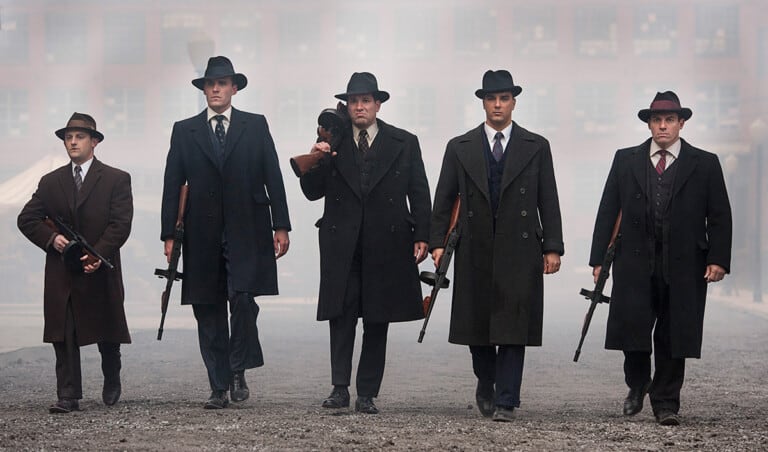Organized Crime in America (1929 – 1951)
1929: Wall Street crash, which forced gangsters to find a new way of making money in a time of recession. 1951: middle of the Cold War.
Kefauver hearings started the huge mystification of the Mafia, discovering that organized crime was still on in the U.S. First TV debates on organized crime.
In history, gangsters and Organized Crime did exist. Between history and culture, there are matters of ideology: in what way does that interact with what was seen on screen?
Presence of censorship and self-regulation for films. Sometimes people wanted to ban or censor gangster films: interactions between politics, culture and crime. Movies influenced the war against crime.
The history of Hollywood is that of people for and against those movies. Creation of compromises: “production code” (not censorship) to see what people disliked and to escape post-censorship.
But how censorship is possible in the US? (c.f. the first Americans and the liberty of expression). It was considered as a commercial venture. A way of skirting the censorship was to show 2 shots to see a person killed instead of one (the latter was prohibited).
The Asphalt Jungle
[8 minutes after the beginning]
The career of a famous gangster, Rocky Sullivan. The idea of compressing several years in 7 minutes. The text and the images are superposed. Importance of the music. Repetition of sequences:
- first evocation of a juvenile gangster.
- then evocation of a famous gangster (wives, champagne, club). The glamorous life of the gangster
The relentlessness of the law: he stole fountain pens and was sentenced to 30 years. Then, when he became a big gangster, he was always acquitted.
Criticism of the American judicial law, which was tough on petty criminals and lenient on gangsters (due to corruption). Such a movie was commenting on the history of the time but was also critical of the America of the 1930s.
Scarface
[middle]
Two identical shots of the scene (medium shots). Gangsters are not colourful people. This movie cannot try to counteract the image of the media.
A certain amount of violence was accepted only if there were more “normal” scenes (like the dialogues at the police station, and at the newspaper’s office…). 2 endings: 2 audiences.
Different modes of communication
The film breaks down the image that each institution had constructed by revealing it. Films might hold contradictory messages.
They are ambivalent and we might not know what to think: there is no single message. We do not have the same vision of violence as the people of the time: violence is different and also depends on social levels, and countries…
Writing belongs to a digital mode of communication. It is digital because it has no objective connection between the meaning and the word.
There is an arbitrary relation between the signifier and the signified (e.g. “cat” and the real cat). But the connection between the image of a cat and the word cat is analogical. You de-code a novel. With a film, you see first and think later. Movies are a mechanical reproduction of images, sound, and movement.
The digital mode of communication is more complex and requires more capacity for abstraction. One word can mean a whole conception.
The analogical mode of communication is on the side of establishing a relationship between foreground and background, between what comes before and after.
The act of reading is different to that of seeing a film. The reader controls the reading (can stop, skip..) whereas in the 1930s you could not do the same with the films.
You could not control the time of viewing. When you see a movie you imagine more or less but you see more. The whole world of the movie is unreal. The perceptions are real but what is shown is unreal (fiction). A movie puts the viewer in a semi-hypnotic state.
With the manipulation of time, and scale (close-ups, long shots..), it distorts perception. The spectator is supposed to be passive: yet, people would never go to the movie if they did not think it was made for them. Dialogues have to be very understandable. Completely artificial and yet it looks natural.
Definition of the Organized Crime
It is non-ideological. Abadinsky states it is a hierarchy with a limited or exclusive membership. It perpetuates itself and is characterized by the willingness to use illegal violence and bribery.
It is specialized in the division of labour, is monopolistic and governed by explicit rules and regulations :
– non-ideological: based on power and money.
– hierarchy: head of a Mafia family.
– membership: does not concern all types of crimes.
– perpetuates: c.f. the Asphalt Jungle: people getting together for a big hold-up and trying to part together afterwards.
– illegal violence and bribery: important for organized crime, an essential part of gangster movies. It showed that America was corrupted.
– division of labour: organized crime is an economic unit. Each gang wants to have a monopoly in its area, hence gang fights in Chicago: you cannot share the place. It is also characteristic of American capitalism.
– rules and regulations: connected with hierarchy. Loyalty is very important.
NOTE: all movies dealing with crime do not deal with organized crime.
It is easy to say that foreigners were responsible for crime and that America would be better off if cleared out. America is (was) a big myth: the land of freedom and opportunity for all.
The first immigrants lived in ghettos, were unemployed, and were subjected to other harsh treatment by the American population. They organized along ethnic lines because America failed to integrate the first generation of immigrants.



